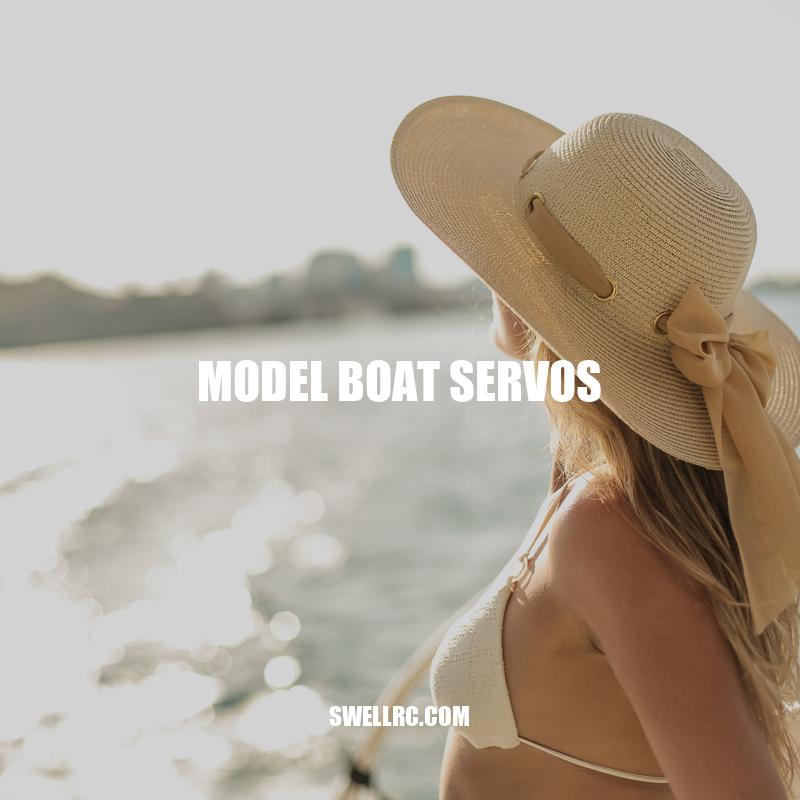Guide to Model Boat Servos: Types, Features, Installation and Maintenance
Model boat servos are an essential component of any model boat. These small electrical motors are responsible for controlling the movements of the sail, rudder, and other important components of the vessel. Model boat servos come in different forms and sizes, each equipped to serve a specific purpose. The purpose of a model boat servo is to convert electrical signals received from a receiver into physical motion. This motion is then used to control the movement of the model boat. Model boat servos come in three main types: standard, mini, and micro. Each type is designed to accommodate specific needs based on the size and type of model boat being used. Understanding the different types, features, and installation methods of model boat servos can help hobbyists and enthusiasts achieve optimal performance for their vessels. With regular maintenance, model boat servos can operate at peak capacity, enhancing the performance and enjoyment of model boat enthusiasts.
Types of Model Boat Servos
There are three main types of model boat servos: standard, mini, and micro. Each type is designed to cater to a different size of the model boat and the amount of strength and torque required in its mechanism. Here are some details about each type:
- Standard Servos: These are the largest and most powerful type of servos and provide the highest amount of torque. They are ideal for larger model boats and need considerable space for installation.
- Mini Servos: These are smaller than standard servos and offer moderate torque. They are ideal for mid-sized model boats and require less installation space.
- Micro Servos: These are the smallest and lightest type of servos and offer low torque. They are designed for smaller-sized model boats and require minimal space for installation.
Model boat enthusiasts can get their hands on model boat servos online as there are several e-commerce websites and online marketplaces that offer a range of high-quality servos, including popular brands such as Futaba, Hitec, and Spektrum. These servos come in different price ranges, depending on the features and capabilities offered. It is essential to choose the right model boat servo based on the desired specifications to ensure optimal performance and control of the vessel.
What are the 3 types of servos?
Servos are important components in various mechanical systems, including robotics, aviation, and manufacturing. They are designed to enable precise and smooth movement control, making them essential for a wide range of applications. There are generally three types of servos: positional rotation, continuous rotation, and linear.
Positional rotation servos are commonly used in robotics and automation systems. They operate by receiving electrical signals that control their speed and direction. They enable precise control over the angular position of a motor, controlling the motion of robot arms, wheel rotation, and other applications that require accurate positioning.
Continuous rotation servos are often used for driving wheels or propellers since they can rotate continuously in either direction. They do not have a specific position as the rotor turns indefinitely, and they operate using similar electrical signal control input as positional rotation servos.
Lastly, linear servos are a type of servo motor that uses a lead screw or a ball screw to create linear motion. They provide linear movement and operate in much the same way as positional or continuous servos, albeit providing a different kind of motion.
In conclusion, understanding the three types of servos is essential when selecting an appropriate servo motor for various applications such as industrial automation, aviation, and robotics. Whether positional rotation, continuous rotation, or linear motion is required, the correct type of the servo must be selected to achieve the desired results.
Features of Model Boat Servos
Apart from their size and torque, model boat servos have several features that can enhance the performance of a model boat. Here are some key features to look out for:
- Speed Control: Servos offer adjustable speed control, allowing for adjustments based on the specific requirements of the model boat. This feature can be especially useful for sailing in challenging water conditions.
- Waterproofing: Some servos come with waterproofing capabilities, which can prevent damage from water infiltration. These servos are essential for model boats that can go underwater and operate in wet conditions.
- Gear Material: The gears in servos can be made from different materials, such as brass, aluminum, or plastic. Each material has different strength and durability levels, which can affect the lifespan of the servo.
- Size of the Output Shaft: The output shaft connects the servo to the sail or rudder of the model boat. The output shaft comes in different sizes, which can affect the amount of torque it can deliver to the sail or rudder.
In addition to these features, some model boat servos also come with advanced capabilities, such as programmable settings and digital display interfaces. These serve as additional tools for hobbyists and enthusiasts to make the necessary adjustments and modifications to enhance their model boat operation. The following table outlines some popular model boat servos available in the market, and their features and specifications.
| Model | Type | Torque (oz-in) | Speed (s/60 deg) | Waterproofing |
|---|---|---|---|---|
| Futaba S3003 | Standard | 44.2 | 0.23 | No |
| Spektrum S6020 | Mini | 54.9 | 0.14 | No |
| Hitec HS-65MG | Micro | 22.8 | 0.14 | No |
| ProTek RC 3710T | Standard | 166.6 | 0.16 | Yes |
How do model servos work?
Model servos are small devices that are essential for controlling all types of remote-controlled vehicles, from planes and helicopters to cars and boats. They are essentially small motors that are combined with a circuit board, a gear train, and a potentiometer to produce a precise and controlled movement.
The way in which model servos work is relatively straightforward. When an electrical signal is sent to the servo, it activates the motor, which turns a small gear. This gear is connected to a larger gear, which in turn engages the output shaft of the servo. As the motor turns the gear, the output shaft rotates as well, providing precise angular control.
To provide precise angular control, model servos incorporate a potentiometer. This is a variable resistor that moves in proportion to the angle of rotation of the output shaft. The rotation of the potentiometer is detected by the servo’s circuit board, which feedback to the controller of the remote-controlled vehicle This enables the controller to adjust the position of the output shaft to within a very small tolerance, making model servos ideal for both precision and control.
Overall, model servos are small but incredibly powerful gadgets that are essential for remote-controlled vehicles. Whether you are flying a plane or racing a car, you can benefit from the precision and control that these devices provide. By understanding how they work, you can gain a greater appreciation for the mechanics of these small but vital components.
Model Boat Servo Installation:
Installing model boat servos properly can make a big difference in how the boat performs and how long the servo lasts. There are several things to keep in mind when installing servos in a model boat.
- Mounting: The servo should be mounted securely inside the boat, preferably with screws or bolts. This will keep the servo from wobbling or shifting when the boat is in motion.
- Connection: The servo arm should be attached securely to the sail or rudder. The connection should be tight enough to transfer the servo’s movement to the boat, but not so tight as to restrict the servo’s movement.
- Wiring: The servo wiring should be hidden and secured inside the boat to prevent tangling and damage during sailing. Make sure the wiring is secured with a zip tie or other fastener to prevent it from coming loose during sailing.
- Test: After installing a servo, it’s important to test it to ensure it’s properly installed and adjusted. Make sure the servo moves the rudder or sail through the proper range of motion. Adjust the servo if necessary before going out for a sail.
If you’re a first-time model boat builder, it might be challenging to install servos on your own. Some hobby shops and online retailers offer installation services and tutorials, which can be a great help. There are also many online resources available, such as YouTube tutorials and online forums, where hobbyists share tips and tricks.
In addition, some products come with an installation manual that walks you through the process step by step. The manual usually contains information on how to connect the servo, how to adjust the settings, and how to test it to ensure it’s working properly.
Don’t forget to check out reliable servo brands that offer high-quality models with different torque specs, sizes, and types. These dependable servos will help you optimize the performance of your model boat.
How do you set servos?
To set servos, there are a few different steps you should take. First, make sure your servo is properly connected to your device and powered on. You can then use software or a controller to adjust the position and movement of your servo. This can typically be done by sending signals to the servo through your device.
One important thing to keep in mind when setting servos is the range of motion that your specific device and servo are capable of. Depending on your equipment, you may need to adjust the movement limits of your servo to ensure that it doesn’t get damaged or move beyond its physical capabilities.
Another factor to consider is the speed at which your servo moves. Some devices may require very slow, precise movements, while others may need quick, sudden movements. Finding the right speed and motion profile for your specific application can take some trial and error, but once you find the right settings, your servo should operate reliably and effectively.
Overall, setting servos is a key part of many robotics and automation applications, and understanding how to do it correctly can help ensure that your project is a success.
Maintaining model boat servos is essential for their longevity and proper operation. Regular care and maintenance can extend the lifespan of the servo and ensure that the model boat operates smoothly. Here are some tips for maintaining model boat servos:
- Cleaning: After every use, clean the servo thoroughly to remove any debris or dirt that may have accumulated on it. Use a can of compressed air or a dry cloth to remove dirt and debris.
- Lubrication: Periodically lubricate the gears inside the servo to keep them moving smoothly. Apply a small amount of lubricant to the gears and spin the servo a few times to distribute the oil.
- Replacement: If a servo becomes damaged or worn out, it’s important to replace it as soon as possible. Delaying a replacement can cause further damage to the servo or the model boat.
- Storage: When not in use, store the servo in a dry and dust-free environment. Keep the servo away from direct sunlight and extreme temperatures. Failure to store the servo properly can lead to damage and malfunction.
In addition to these tips, there are some products available that can help with the maintenance of model boat servos. For example, some manufacturers offer servo grease and oil for lubricating the gears, and servos savers to prevent wear and damage of the servo gears. These products can often be found at hobby shops or online retailers that sell model boat parts.
Regular maintenance of the model boat servos will keep them in optimal condition and prolong their lifespan, ensuring many enjoyable sailing sessions to come.
How long do servos last?
Servos are commonly used in remote controlled toy cars, planes and boats as well as in robotics and automation. One of the most frequently asked questions about servos is “how long do they last?”
Although it is difficult to provide a definitive answer, the typical lifespan of a servo can be anywhere from a few months to several years, depending on factors such as usage, quality and maintenance.
If a servo is used regularly and exposed to harsh conditions, such as dust, water or extreme temperatures, it may have a shorter lifespan. Additionally, if it is made of quality materials and receives proper care and maintenance, it can last longer.
Furthermore, just like any other electronic device, servos can fail unexpectedly due to manufacturing defects or other unforeseen problems. Therefore, it is important to purchase servos from reputable manufacturers and to monitor their performance regularly.
In general, a well-maintained servo can last for years, providing smooth and precise movements. However, it is important to keep in mind that the lifespan of a servo can vary greatly depending on various factors, so it’s always a good idea to keep a spare on hand just in case.
Conclusion
In conclusion, model boat servos are a critical component of any model boat, allowing for precise control of the vessel’s movements on the water. Hobbyists and enthusiasts who invest the time and effort to understand the different types, features, and installation methods of servos will be rewarded with a well-operating model boat. Properly maintaining the servos can also help ensure they have a long lifespan. Regular cleaning, lubrication, and replacement of damaged components go a long way in keeping the servos running smoothly. When choosing model boat servos, it’s important to consider the type of boat and the intended use. By following these tips and choosing the right servos for the job, model boat enthusiasts can enjoy their hobby to the fullest.



